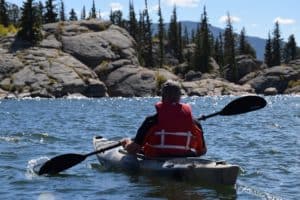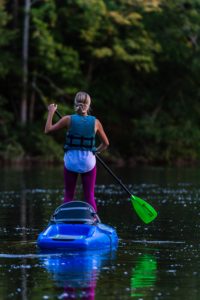I recently learned that the majority of my kayaking friends cannot swim and to say I was astonished was an understatement. I did some searching around to find out that a survey conducted by The American Red Cross concluded that only 56 percent of Americans can perform the five core swimming skills. I decided to sit down and do some research and compile a resource for kayakers who cannot swim.
Although the ability to swim is an important skill, it is not necessary to kayak. There are several precautions you can take if you can’t swim such as wearing a PFD (personal flotation device) and avoiding areas that are above your skill level.
The Different ‘Forms’ of Kayaking
Kayaking is a hobby that takes on many forms which range from a relaxing hobby to an adrenaline pumping extreme sport. Personally, I use my kayak to fish. Knowing what type of kayaking you will be doing is important to determine your comfort level when venturing out into the water without knowing how to swim.
Touring – The most common type of kayaking that is enjoyable at all skill levels. Touring usually consists of several hour trips called a ‘floats’ down a long, slow-moving river or a small lake.
Sport – A style of kayaking gaining popularity quickly, and for good reason. Some kayaks come equipped with rod holders for fisherman, a cut out for a dive tank for a diver, and even cargo storage for those campers who want to get a little farther away than the average campsite.
Ocean – A versatile style of kayaking in terms of what reason people have of kayaking in the ocean. The ocean can be a dangerous place, waves can capsize you and the weather can turn in an instant.
White Water – This is where the action happens, fast-moving water and the very high possibility to be thrown from your kayak multiple times.
Regardless of what form of kayaking you intend to dive into, if you cannot swim a PFD is your absolute best friend.

What is a PFD and Why You Need One
Personal flotation devices (PFD) come in all shapes and sizes and picking out the right one for you is crucial. Unfortunately, that can be a little harder than you might think so I am going to touch on choosing a PFD at the end of the article.
If your PFD is fitted correctly, you cannot sink. They work by adding buoyancy to your body allowing you to easily float in the water.
There are five different types of PFDs approved by the United States Coast Guard, but only the ‘standard’ and ‘inflatable’ PFDs are used for kayaking.
Once you purchase your PFD, you may want to practice in a swimming pool or pond. This will help you understand how your PFD handles in water so that you’re not caught off guard should you find yourself going for a swim. Just keep in mind that practicing in a controlled environment is different than falling from your kayak because you will not be able to see your feet or grab a hold of the side of the pool.
I recommend this PFD on Amazon. It is inexpensive and does its job well.
Falling From Your Kayak
The elephant in the room for non-swimmers, falling out of your kayak. Depending on your chosen style of kayaking, you may be more at-risk than others. Even if you aren’t white-water kayaking, you may find your kayak on its top with you underneath.
Personally, I once saw a snake fall from a tree into a fisherman’s kayak. As anyone would, he freaked out and inevitably flipped his kayak. Luckily he was a prepared and experienced kayaker who was able to regain control of the situation and remount his kayak.
The best way to prepare for the unexpected is to practice flipping your kayak, this is called a ‘wet exit’.

Practicing a Wet Exit
This is the practice maneuver that nearly everyone hates, especially nonswimmers. A wet exit is a controlled flip of your kayak so that you can learn and practice what to do when the time comes that you actually flip your kayak.
Depending on your choice of a kayak, this may be easier than others. Sit-on-top kayaks are easier because you just fall off, but your standard kayak requires you to sit in it.
The wet exit is taught by all kayak safety courses, requiring students to successfully perform it before passing. After you get your first one down, you may still be nervous about flipping out in the field but you will be adequately prepared.
Some Tips on Kayaking for Non-Swimmers
- Choose a stable kayak
- Never go beyond your comfort zone
- Some parks or lodges offer guided kayak trips, which are good for beginners
- The same parks generally offer classes for beginners
- Always go with a friend
- Some states require a PFD, some do not
- Storms can sneak up on you and quickly change the way water behaves
- It is never to late to learn how to swim, find a class near you
Basic PFD Guide
Standard PFDs
The most common form of PFDs that the majority of recreational kayakers wear. The is a vest and packed full of a flotation material, which is generally foam. These are labeled as a Type III USCG-approved PFD.
Pros
- Very low maintenance: Wipe it down with a wet rag every once and a while and store it in a dry place out of the suns reach.
- Always ready: No activation required, just put it on properly.
Cons
- Hot: These PFDs can get a little warm on summer days.
- Bulky: Standard PFDs can be quite bulky making it hard to paddle or maneuver in the kayak.
Inflatable PFDs
Inflatable PFDs are gaining popularity and for good reason. They are slim and come in a couple of different forms allowing paddlers to choose which one best suits their needs. The inflatables also have the ability to inflate one of two ways depending on style. Manual, the first style features a pull cord for the wearer to tug when he or she feels necessary. The manual variant is more geared towards more active sports because of the likelihood of getting wet. The other, automatic design, inflates instantly upon submersion.
Pros
- Comfortable: their slim fit makes them comfortable and less likely to interfere with your range of movement.
- Cool: Won’t cause you to overheat on a summers day
Cons
- Require inflation: If your PFD fails or you are wearing one that requires manual inflation and is unable to inflate it for any reason, well, you can do the math.
- Personal preference: The inflatable PFDs are not recommended for nonswimmers or whitewater kayakers.

Fitting your PFD
PFDs are fit by the size of your chest, not by your weight.
Loosen all the straps and put on the PFD, tighten up the straps starting at the waist and ending with the shoulders.
The PFD should fit snugly but not uncomfortably.
Have someone pull up on the PFD to ensure proper fit. If the PFD pulls up past your nose it either needs to be tightened or the vest is too large.
Quick Tips on PFDs
- Find somewhere to sit down to see how the PFD will fit you when you sit in the kayak
- Try practicing some paddling motions to see if the PFD suits you
- There are specific PFDs designed for females to provide a more contoured fit.

